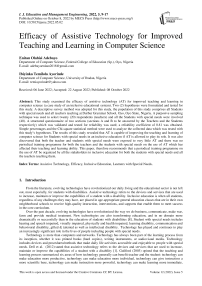Efficacy of Assistive Technology for Improved Teaching and Learning in Computer Science
Автор: Enitan Olabisi Adebayo, Ibiyinka Temilola Ayorinde
Журнал: International Journal of Education and Management Engineering @ijeme
Статья в выпуске: 5 vol.12, 2022 года.
Бесплатный доступ
This study examined the efficacy of assistive technology (AT) for improved teaching and learning in computer science (a case study of an inclusive educational system). Two (2) hypotheses were formulated and tested for this study. A descriptive survey method was adopted for this study, the population of this study comprises all Students with special needs and all teachers teaching at Durbar Grammar School, Oyo, Oyo State, Nigeria. A purposive sampling technique was used to select twenty (20) respondents (teachers) and all the Students with special needs were involved (40). A structured questionnaire of two sections (sections A and B to be answered by the Teachers and the Students respectively) which was validated and tested for reliability was used; a reliability coefficient of 0.81 was obtained. Simple percentages and the Chi-square statistical method were used to analyze the collected data which was tested with this study’s hypotheses. The results of this study revealed that AT is capable of improving the teaching and learning of computer science for Students with special needs in an inclusive education if AT is allowed to play its role. It was also discovered that both the teacher and students with special needs were exposed to very little AT and there was no periodical training programme for both the teachers and the students with special needs on the use of AT which has affected their teaching and learning ability. This paper, therefore recommends that a periodical training programme on the use of AT be organized by all the stakeholders in inclusive education for both the students with special needs and all the teachers teaching them.
Assistive Technology, Efficacy, Inclusive Education, Learners with Special Needs
Короткий адрес: https://sciup.org/15018570
IDR: 15018570 | DOI: 10.5815/ijeme.2022.05.02
Список литературы Efficacy of Assistive Technology for Improved Teaching and Learning in Computer Science
- A. Dell, D. Newton, & J. Petroff, (2012). Assistive technology in the classroom: Enhancing the school experiences of students with disabilities (2nd ed.). Boston, MA: Pearson.
- Å. Grönlund, N. Lim, & H. Larsson, (2010). Effective use of assistive technologies for inclusive education in developing countries: Issues and challenges from two case studies. International Journal of Education and Development using ICT, 6(4), 5-26.
- A. N. Liman, R. O. Adebisi, J. E. Jerry, & H. G. Adewale, (2015). Efficacy of assistive technology on the educational programme of children with learning disabilities in inclusive classrooms of Plateau State Nigeria. Journal of Educational Policy and Entrepreneurial Research, 2(2), 23-32.
- B.A. Mary (2019). Perception of teachers in regular schools towards inclusive education in Tano South District, Brong Ahafo Region, Ghana. International Journal of Education, Learning and Development. Vol.7No.1, pp 48-58. Published by European Centre for Research Training and Development UK(www.eajournals.org).
- C. A. Michaels, & J. McDermott (2003). Assistive technology integration in special education teacher preparation: Program coordinators' perceptions of current attainment and importance. Journal of special Education technology, 18(3), 29-44.
- C.M. Okolo, & J. Diedrich, (2014). Twenty-five years later: How is technology used in the education of students with disabilities? Results of a statewide study. Journal of Special Education Technology, 29(1), 1-20.
- D. Edyburn, & R. Gersten (2007). Defining quality indicators in special education technology research. Journal of Special Education Technology, 22(3), 3-18. Doi:10.1598/RRQ.42.1.7
- D.H. Rose, T.S. Hasselbring, S. Stahl & J. Zabala (2005). Assistive technology and universal design for learning two sides of the same coin. In D. Edyburn K. Higgins, and R. Boone (eds). Handbook of Special Education Technology Research and Practice. Whitefish Bay, WI: Knowledge By Design. 507 – 511.
- E.K. Guilford (2003). Assistive technology for students with Intellectual Disability. Wikidot.com Retrieved from: http//assistive-technology-students-behaviour-disorder-html.
- F. K. Ahmad (2015). Use of assistive technology in inclusive education: making room for diverse learning needs. Transcience, 6(2), 62-77.
- F. Yufen (2011). Discussion on teaching in computer course of information and computing science. International Journal of Education and Management Engineering, 1(3), 53. Published Online in MECS (http://www.mecs-press.net) DOI: 10.5815/ijeme.2011.03.08
- I. Olatunji & E. O. Babalola, (2022). Undergraduates with special needs’ awareness towards the use of assistive technology for learning at the university level. ASEAN Journal of Community and Special Needs Education, 1(2), 45-54.
- J. Specht, G. Howell, & G. Young (2007). Students with special education needs and their use of assistive technology during the transition to secondary school. Childhood Education, International Focus Issue, 83, 385-389. Doi:10.1080/00094056.2007.10522956
- J.R. Ufford (2007). Definition and Concept of Assistive Technology Equipment Available in Education: Azizbejan Printing 75 – 88.
- K. Cushner, A. McClelland, & P. Safford (2012). Creating inclusive classrooms. Human diversity in education. New York, New York:McGraw-Hill.
- L. Lei (2011, March). Research and Practice on Media Assistive High Efficient Autonomous Learning Mode. In Proceedings of the 2011 Third International Workshop on Education Technology and Computer Science-Volume 01 (pp. 603-605). Published Online in MECS (http://www.mecs-press.net) DOI: 10.5815/ijeme.2011.01.07
- R. Joseph (2013). Assistive Technology in Education; Retrieved from http://www.google.com/assitive-technology-in-education.
- S. Saleem, S. Sajjad & M. B. Rauf (2019). Training facilities provided by special education schools to students with visual impairment and teachers to use assistive technology. Training, 10(1), 91-100.
- T. Alquraini, G. & D. Dianne Gut, (2012). Critical Components of Successful Inclusion of Students with Severe Disabilities Literature Review. International Journal. Retrieved from: https://study.com/academy/lesson/what-is-special-needs-definition-types-law.html. 27(1), 42-59.
- W. Al-Ani, A. Al Musawi, W. Al-Hashmi, & B. Al-Saddi (2020). Status of Using Assistive Technology by Students with Disabilities at Sultan Qaboos University.
- X.T. Bui, C. Quirk, S. Almazan, & M. Valenti, (2010). Inclusive Education Research & Practice. Retrieved from https://www.semanticscholar.org/paper/Inclusive-Education-Research-%26-Practice-Bui-Quirk/0d7f0e817492632f1509ec34f4908d777bb83a32


